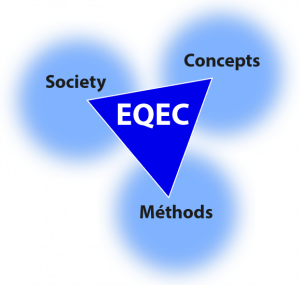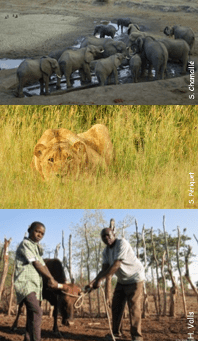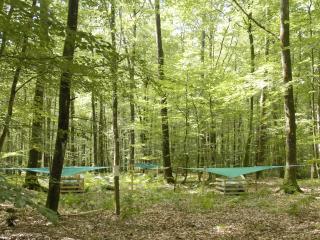Quantitative and Evolutionary Ecology of Communities Group
Members

Doctorante
UCBL

Professeure des universités
VetAgro-Sup
Tel: 33 04 72 43 27 56

Directeur de recherche
CNRS
Tel: 33 04 72 43 27 57

Doctorant
UCBL
Tel: 04 72 44 81 42

Doctorant
CNRS
Tel: 04 72 44 81 42
Doctorant
VetAgro-Sup

Maître de conférences
UCBL
Tel: 04 72 44 81 42
Doctorant
UCBL


Professeur des universités
UCBL
Tel: 33 04 72 43 27 56

Professeur des universités
UCBL

Directeur de recherche
CNRS
Tel: 33 04 72 43 27 56

Maîtresse de conférences
UCBL
Tel: 33 04 72 43 29 02
Maître de conférences
UCBL
Tel: 33 04 72 43 29 02

Our research activities, focused on interspecific interactions (community ecology), aim to better understand the ecological and evolutionary processes structuring species assemblages and biodiversity at different temporal and spatial scales. Our team addresses these major issues using contrasting biological models (communities of large African mammals, insects, microbiota, plants) from 3 complementary angles:
- Our work is strongly anchored in the conceptual framework of evolutionary biology by studying (i) the diversity of adaptive responses implemented by organisms to selective pressures in their environment, (ii) their consequences on population demography and ultimately (iii) the dynamics and composition of species communities.
- Our research is closely linked to societal issues of biodiversity conservation and management by integrating both the functioning of socio-ecological systems and the context of climate change. We conduct experimental studies, manage and ensure the long-term monitoring of several community observation networks.
- Methodological issues also occupy a central place in our team, with the development of new tools for statistical processing and modeling of ecological data. This activity leads to the development of methods and software that we develop and distribute freely.
Research programs

Functioning of African savanna communities
The Hwange LTSER (Long-Term Socio-Ecological Research site in Zimbabwe hosts a long-term interdisciplinary research program that focuses on the functioning of plant and animal communities within the Hwange National Park and the interactions between this protected area and humans living in its periphery. Based on this program, three axes are developed: (1) studying the population dynamics of elephants, exploring their impact and that of management policies on the socio-ecosystem functioning; (2) Understanding the extent to which interactions within and between trophic levels are sensitive to management actions (e.g. sport hunting, water management) and climate change; (3) Decoding human ecology and human-wildlife coexistence mechanisms towards integrated conservation and sustainable functioning of the socio-ecosystem. This research is complemented by more recent works in the Hluhluwe-iMfolozi Park and in the Madikwe reserve in South Africa, which focus on the role of environmental conditions on the hunting success of large African carnivores. We work in close collaboration with the IRL (International Research Lab) Rehabs.
Involved group members : Alice Bernard, Laura Lacomme, Aïssa Morin, Lisa Nicvert, Elie Pedarros, Yolan Richard, Marion Valeix*

Masting and the community dynamics of seed consumers
Masting is a reproductive strategy often encountered in perennial plants, characterized by fructifications highly fluctuating in time and being synchronized at the population level. The seeds produced that way constitute a pulsed resource with a strong impact on the eco-evolutionary dynamics of seed-consuming communities and forest regeneration. Our lack of knowledge of this system still impedes our understanding of the dynamics of temperate forest ecosystems and its future in the context of climate change. Our work carried out on oak forests aims to better understand (i) the proximal causes of masting, (ii) the mechanisms underlying the coexistence of species competing for such highly fluctuating resource and (iii) the co-evolution of consumer exploitation strategies for the fluctuating resource and forest tree fruiting strategies. On the basis of the results obtained, scenarii will be proposed on the future of forest regeneration under climate change, that may serve forest management.
Involved group members : Marie-Claude Bel-Venner*, Emilie Fleurot, Léa Keurinck, Jean Lobry, Samuel Venner

The spread of antibiotic resistance genes in bacteria
Antibiotic resistance is recognized as one of the greatest current threats to human health, and the mobile genetic elements (MGEs) that circulate in bacterial populations and communities are the main vehicles. To understand the dynamics and diversity of MGEs in bacterial pangenomes and the emergence of antibiotic resistance genes, we propose to go beyond the framework of conventional genomics by considering pangenomes as complex ecological communities. In the Ab-One program, we mobilize the concepts and tools developed in community ecology based on an integrative approach (monitoring of bacterial populations/communities evolving in contrasting environments -One-Health approaches-, pan-genomic analyses, experimentation in molecular and cellular microbiology, mathematical modelling). This program is currently focused on the dynamics of MGEs in Acinetobacter baumannii, an antibiotic-resistant microorganism classified as a priority by the WHO. Other more general approaches will illustrate the relevance of this new conceptual framework to understand the dynamics and diversity of MGEs in bacterial pangenomes. This program, co-piloted by our team and a team from CIRI (Horigene) involves the participation of 9 organizations (6 from Lyon -LBBE, CIRI, MMSB, HCL, LEM, VetAgro Sup-, Institut Pasteur (Paris), LMGM (Toulouse ), Robert Koch Institute (Germany)).
Involved group members : Stéphane Dray, Rémi Tuffet, Samuel Venner*

Statistical analysis of ecological data
Understanding the structure and dynamics of species assemblages, and the processes behind them, requires collecting data that are becoming increasingly complex owing to the sophisticated technological developments made available for their acquisition (e.g. GPS, loggers, satellite imagery, molecular data). We are developing new methods for analysing such data, that provide new insights into the ecological processes at work in communities. Multivariate analysis methods allow the analysis of spatial structures, accounting for various information on species (functional traits, morphology, phylogeny), the spatio-temporal variation of species-environment relationships or the multifaceted perception of the protected human-environment relationship. We also model multi-'omics' dose-response data within communities in order to better understand the Adverse Outcome Pathway (AOP) and to better appreciate the risks to the environment. These methodological innovations are made available to the scientific community through the development, distribution and maintenance of software (libraries for the R language: ade4, adegraphics, adephylo, ade4TkGUI, nlstools, fitdistrplus, DRomics, seqinr).
Involved group members: Marie Laure Delignette-Muller, Stéphane Dray*, Jean Lobry, Jean Thioulouse.
Publications
Display of 271 to 300 publications on 656 in total
Stabilisation of soil aggregates along a plant community succession: indirect positive effects of root biomass and root diameter diversity
Sfécologie-2016, International Conference of Ecological Sciences . : np
Conference paper
see the publicationPlant diversity loss forces shift in ecological strategies for wild bees - Insights from historical time series at a country-wide scale
Sfécologie-2016, International Conference of Ecological Sciences . : np
Conference paper
see the publicationEcological, biogeographical and evolutionary drivers of tree rarity in Indian rainforests
5th International EcoSummit Congress "EcoSummit 2016 - Ecological Sustainability: Engineering Change .
Conference paper
see the publicationUnderstanding plant community successional dynamics: Exploring the role of fine root morphological heterogeneity
EcoSummit 2016, The 5th International EcoSummit Congress on Ecological Sustainability: Engineering Change .
Conference paper
see the publicationInfluence of long-term biogeography and evolution on current patterns of rarity: consequence for conservation strategies
The 5th International EcoSummit Congress on Ecological Sustainability: Engineering Change (EcoSummit 2016) .
Conference paper
see the publicationCushion plants in high-elevation peatlands of Andes determines the functional and taxonomic composition of associated plant communities under intense herbivory and abiotic stress
EcoSummit 2016, The 5th International EcoSummit Congress on Ecological Sustainability: Engineering Change .
Conference paper
see the publicationInto the functional ecology of ectomycorrhizal communities: environmental filtering of enzymatic activities
Journal of Applied Ecology . 13 ( 8 ) : 1585-1598
Journal article
see the publicationGrowth rings in tropical trees: role of functional traits, environment, and phylogeny
Trees - Structure and Function .
Journal article
see the publicationDynamics of trace element accumulation at the plant communauty level along mediterranean roadside secondary succession
10. ISEB conference . : np
Conference paper
see the publicationCSR ecological strategies and plant mating systems: outcrossing increases with competitiveness but stress-tolerance is related to mixed mating
Oikos . 125 ( 9 ) : 1296-1303
DOI: 10.1111/oik.02328
Journal article
see the publicationGeometrical envelopes: Extending graphical contemporary niche theory to communities and eco-evolutionary dynamics
Journal of Theoretical Biology . 407 : 271-289
Journal article
see the publicationFruiting Strategies of Perennial Plants: A Resource Budget Model to Couple Mast Seeding to Pollination Efficiency and Resource Allocation Strategies
The American Naturalist . 188 ( 1 ) : 66-75
DOI: 10.1086/686684
Journal article
see the publicationMolecular phylogeny of the highly diversified catfish subfamily Loricariinae (Siluriformes, Loricariidae) reveals incongruences with morphological classification
Molecular Phylogenetics and Evolution . 94 : 492-517
Journal article
see the publicationInterspecific interference competition at the resource patch scale: do large herbivores spatially avoid elephants while accessing water?
Journal of Animal Ecology . 85 ( 6 ) : 1574-1585
Journal article
see the publicationImpact of Wheat/Faba Bean Mixed Cropping or Rotation Systems on Soil Microbial Functionalities
Frontiers in Plant Science . 7 : 1364
Journal article
see the publicationSpatial Distribution of a Large Herbivore Community at Waterholes: An Assessment of Its Stability over Years in Hwange National Park, Zimbabwe
PLoS ONE . 11 : e0153639
Journal article
see the publicationThe global spectrum of plant form and function
Nature . 529 ( 7585 ) : 167-71
DOI: 10.1038/nature16489
Journal article
see the publicationAddressing ecological effects of radiation on populations and ecosystems to improve protection of the environment against radiation: Agreed statements from a Consensus Symposium
Journal of Environmental Radioactivity . 158-159 : 21-29
Journal article
see the publicationOccurrence of Stenotrophomonas maltophilia in agricultural soils and antibiotic resistance properties
Research in Microbiology . 167 ( 4 ) : 313-324
Journal article
see the publicationBacterial community structure at the microscale in two different soils
Microbial ecology . 72 ( 3 ) : 717-724
Journal article
see the publicationAnalysis of hemocytes in Lymnaea stagnalis: Characterization and effects of repeated hemolymph collections
Fish and Shellfish Immunology . 57 : 116-126
Journal article
see the publicationRecommendations for the analysis of hemocyte-related immunocompetent oxidative activity in the freshwater snail Lymnaea stagnalis
Journal of Xenobiotics . 6 : 25-27
Journal article
see the publicationBeyond ectomycorrhizal bipartite networks: projected networks demonstrate contrasted patterns between early- and late-successional plants in Corsica
Frontiers in Plant Science . 6 : 881
Journal article
see the publicationRecent declines and range changes of orchids in Western Europe (France, Belgium and Luxembourg)
Biological Conservation . 190 : 133-141
Journal article
see the publicationLong-Distance Rescue and Slow Extinction Dynamics Govern Multiscale Metapopulations
The American Naturalist . 186 ( 4 ) : 460-469
DOI: 10.1086/682947
Journal article
see the publicationÉtude des réseaux en écologie
Analyse des réseaux sociaux appliquée à l'éthologie et à l'écologie . 978-2-919694-98-3 : 49-98
Book chapter
see the publicationIntrinsic and extrinsic influences on tropical tree growth ring formation
4th International Conference of the Asian Dendrochronological Association .
Conference paper
see the publicationEverything is NOT everywhere: network and trait-based approaches to microbial communities
Annual Meeting BES .
Conference paper
see the publicationVegetation ecology meets ecosystem science: Permanent grasslands as a functional biogeography case study
Science of the Total Environment . 534 ( 15 november 2015 ) : 43--51
Journal article
see the publicationField Application of the Mycorrhizal Fungus Rhizophagus irregularis Increases the Yield of Wheat Crop and Affects Soil Microbial Functionalities
American Journal of Plant Sciences . 06 : 3205-3215
Journal article
see the publication
You also, comment on this article